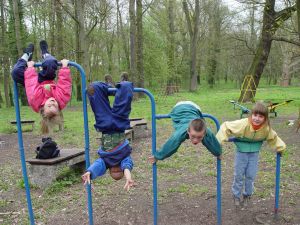By Naomi Aldort, author of Raising Our Children, Raising Ourselves, www.AuthenticParent.com.

Q: My daughter-in-law is into a way of raising our grandchildren that includes cosleeping, organic food, wooden toys and so on. She and our son are very protective of their ways and forbid me from bringing certain gifts and doing “grandma” kinds of things with them, like going for ice cream, taking them to a movie or buying toys. How can I have more relationship with my grandchildren in spite of these limitations?
A: As grandparents, we are in love with the little ones and yearn to be part of their lives. Your question is, therefore, very useful for every grandparent. And yes, there is a way to nurture the connection with your grandchildren when the parents are choosing loving ways that differ from yours.
I recall counseling a family when the young father said to his parents, “You did your parenting experiment, raising me and my sister. We are doing ours with our daughters.”
“Experiment?” The grandpa was horrified and offended. “We didn’t experiment. We knew how to be parents,” he said confidently.
“Did we?” asked an honest grandma, with a twinkle in her eye. “I often didn’t know what I was doing. I think our son has a point. Their way could be better, and anyway, it is their turn to be parents in their own way.”
Your children may be happy adults, so it is easy to feel sure that what you did was the best. But can you really know? Can you know how they would have matured if brought up in a different way? We cannot know, and it is indeed always an “experiment” to raise a child. There is more than one loving way to nurture a young one.
Creating connection
Some young parents follow the footsteps of their parents and welcome a grandparent’s ways, while others blaze a new trail. Your son is obviously on a different parenting path. Let’s imagine two different grandmas in this same dilemma, handling it in two different ways. One grandma wants do things her way, while the other respects her children’s parenting wishes. Who of the two is going to build more connection with the grandchildren and with the whole family?
Visits and gifts
In scenario one, Grandma arrives for a visit with gifts. She enters the house, and right away there is tension. As she gives the gifts to the grandchildren, the parents share glances of distress. They go to the other room to discuss how to get rid of what they see as harmful toys. They have worked so hard to keep the children away from such toys or influences, and they will tend to view Grandma as an enemy rather than an ally. Such parents call me for advice and say with anguish, “She is ruining everything.” If they try to talk to Grandma about it or get rid of the toys, there will be arguments instead of connection and joy.
The other grandma, who decided to honor her children’s ways, arrives either with gifts that have been agreed upon in advance or without gifts. After a while she may say, “I would love to see what you may want me to get for you from the wonderful catalog your mom told me about.” Everyone sits together excitedly, and the connection is strong. Grandma includes the parents in making the buying choices. Or Grandma’s treat may be going to the zoo or some other experience that the parents feel good about. Giving experiences together is a lifelong gift of love and connection.
Taking them out for ice cream
What about the ice cream? Some parents may be comfortable allowing treats like ice cream, for special occasions or more often, while others prefer not to. In our example, the first grandma either takes the kids for ice cream against the parents’ will or knowledge, or she doesn’t but she resents it. Either way there is secrecy and a sense of disconnection and anger. If the kids get a treat without the parents’ knowledge, the parents will probably find out eventually, and it will erode trust, connection and honesty between parent and child.
The second grandma is delighted to learn what natural sweets are available at the health food store or what the parents are making at home that is wholesome and sweet. She is learning something new and feeling excited and belonging. She may buy a recipe book for sweet treats without sugar and contribute to the whole family. She may also ask the parents for suggestions on where to take the children for special treats.
Going to the movies
The first grandma may have an argument with the parents and end up not going to the movie but feeling angry and disconnected. The children may feel that their parents are preventing them from having fun, and after Grandma leaves, they become aggressive and resentful toward their own parents. The parents resent Grandma and may reduce the visits with her. Or, if this grandma does get her way, the resentment will be even greater. The children may want more movies, toys related to the movie, and other items and experiences their parents were trying to protect them from. Grandma will end up with less connection, as she will be resented and not trusted to spend time with the children on her own.
Meanwhile, the grandma who chooses to respect the parents’ choices is spending her afternoon in the park instead of the movies. She is naturally connecting with the grandchildren but also staying connected with her grandchildren’s parents. This is not her turn to choose how to parent. She enjoys the freedom to follow rather than lead. She joins the ride and enjoys herself. When she observes something her old ways tell her to change, she questions her own convictions and opens herself to new ways of thinking. She doesn’t need to agree, only to respect. She has a wonderful time with the grandchildren and will be welcomed to visit or host the grandchildren often.
Choose the kind of grandparent you wish to be
What will bring more connection between you and your grandchildren, and between you and your children—defending some “rights” (which you don’t really have) or joining their ride?
When we defend our position, our “rights” and our opinion, we create separation, confusion, misunderstanding and struggle. When we defend, we are set on manipulating the people and conditions to fit our agenda, and it often hurts and brings stress into the relationships.
We are not talking here about parents who hurt their children but about loving parents whose ways differ from yours. When your son was four and wanted to play in the sand, you honored his wish, and he played his way. Now that he is a father, support him by offering to be with the children in a way that respects his well-thought-out efforts.
We often don’t realize that by exposing a child to something his parents oppose, we set him up against his mother and father, creating much strife even after our departure. The words “Mom, I want … Grandma said it is OK. … ” are dreaded by parents everywhere. If, instead of manipulating people and conditions, we respond to their loving ways, we create the connection we want, and we build trust. Your son is more likely to listen to you when you show up as his ally.
Of course, you can express your concerns and opinions, just don’t expect your son and daughter-in-law to follow your advice. It is their turn. It is the time for you to follow and not lead. If you want to have an easier time, try to understand them, read the parenting books or articles they are reading, or listen to the CDs they are inspired by. Some grandparents contact professionals for advice in order to learn and support their children’s ways of parenting. Go for the ride as a passenger, not a driver, and you will have the greatest connection any grandparent can have.





 Some years ago, my oldest son forgot his shoes on a routine trip to the grocery store. We’d struggled with the “shoe issue” for a while, and I hadn’t come up with a workable solution to help him remember to bring his shoes when we had errands to run. Frequently, we’d have to double back to the house to retrieve a pair, and I’d be impatient and irritable. This day, I decided to let him take charge. We arrived at the store and, sure enough, his shoes were nowhere to be found. He ended up wearing his little sister’s flip-flops for the (mercifully short) shopping trip. He never again forgot his shoes.
Some years ago, my oldest son forgot his shoes on a routine trip to the grocery store. We’d struggled with the “shoe issue” for a while, and I hadn’t come up with a workable solution to help him remember to bring his shoes when we had errands to run. Frequently, we’d have to double back to the house to retrieve a pair, and I’d be impatient and irritable. This day, I decided to let him take charge. We arrived at the store and, sure enough, his shoes were nowhere to be found. He ended up wearing his little sister’s flip-flops for the (mercifully short) shopping trip. He never again forgot his shoes. One of the hardest situations I face in my household is when one of my children hurts the other one, whether by accident or in play or out of anger. My knee-jerk reaction is to tell the offender to say sorry to her sister, just as my parents had me do when I was younger. My mom would tell me to say sorry and if I did it quickly to get it over with but didn’t really want to say it, she’d say, “Say it like you mean it.”
One of the hardest situations I face in my household is when one of my children hurts the other one, whether by accident or in play or out of anger. My knee-jerk reaction is to tell the offender to say sorry to her sister, just as my parents had me do when I was younger. My mom would tell me to say sorry and if I did it quickly to get it over with but didn’t really want to say it, she’d say, “Say it like you mean it.” Dahlia was running around the house screaming and crying. “I hate her! I hate her! I will never play with her again!”
Dahlia was running around the house screaming and crying. “I hate her! I hate her! I will never play with her again!”